Conservation Framing
About Cindy’s Conservation Framing Policy
 Conservation picture framing is a technique that utilizes established procedures, materials, and techniques to effectively protect and maintain art in as close to its original condition as possible. There is one caveat however that needs to be considered when discussing conservation framing: There are no guarantees that art will last forever. Age will eventually claim all forms of art. However, the key is to delay the aging process. We believe every attempt should be made by custom picture framers to prolong the life of items they frame. To effectively perform this task, we employ proven methods and use materials to slow the deterioration process. Thus, the process enables you to enjoy your art for many years, and even for generations. For this reason we urge prospective clients to seek the services of a conservation-grade picture framer before framing art. The information published on this website and our sister website, Framed Guidons, provides a wealth of information about the benefits of conservation framing. In this section, our goal is to educate your about the steps necessary to protect art.
Conservation picture framing is a technique that utilizes established procedures, materials, and techniques to effectively protect and maintain art in as close to its original condition as possible. There is one caveat however that needs to be considered when discussing conservation framing: There are no guarantees that art will last forever. Age will eventually claim all forms of art. However, the key is to delay the aging process. We believe every attempt should be made by custom picture framers to prolong the life of items they frame. To effectively perform this task, we employ proven methods and use materials to slow the deterioration process. Thus, the process enables you to enjoy your art for many years, and even for generations. For this reason we urge prospective clients to seek the services of a conservation-grade picture framer before framing art. The information published on this website and our sister website, Framed Guidons, provides a wealth of information about the benefits of conservation framing. In this section, our goal is to educate your about the steps necessary to protect art.
Methods Used In Conservation Picture Framing
There are a few ways to protect your art from damage. We know most people truly want to protect their art. Their motivation may be based on commercial considerations or for sentimental purposes. In either case, we want you to know about some of the procedures and materials we use to safeguard art.
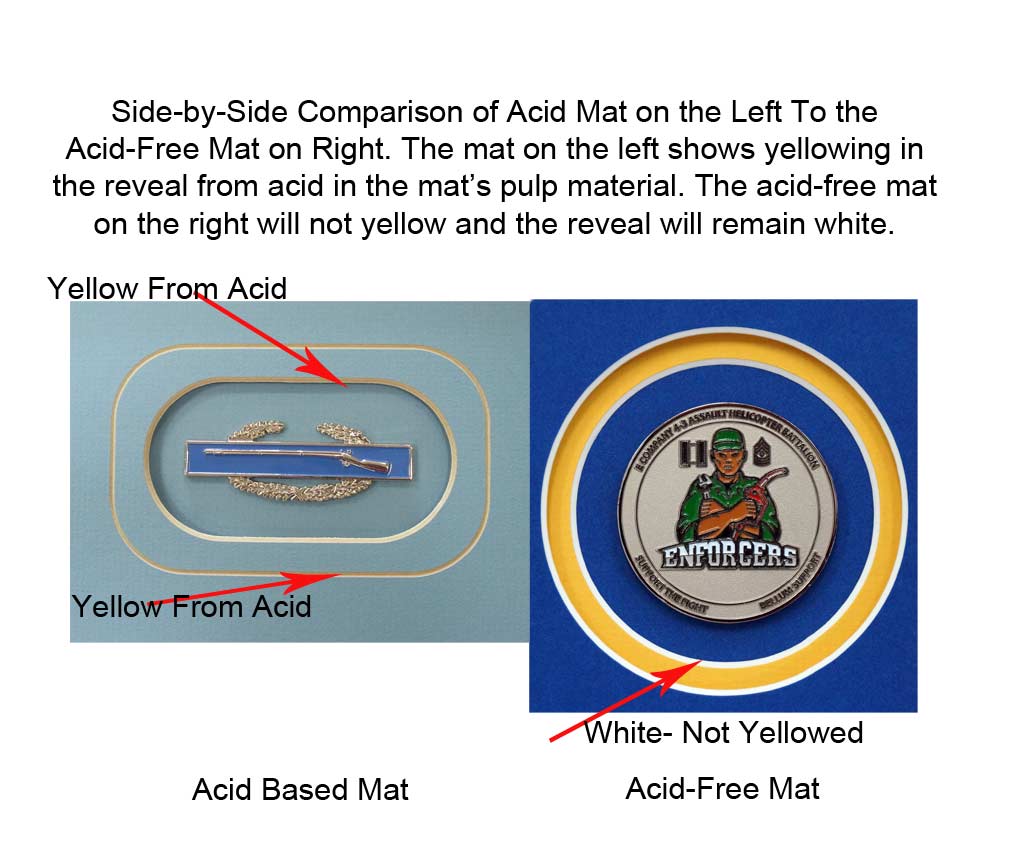 First, the biggest issue in picture framing which results in early art deterioration involves the use of cheap mats. Cheap mats contain acid from wood products. It is important to understand that not all paper products are created equal! Ordinary pulp-based mat board contains acids and lignin which, over time, will damage the artwork which the mats come into contact with.
First, the biggest issue in picture framing which results in early art deterioration involves the use of cheap mats. Cheap mats contain acid from wood products. It is important to understand that not all paper products are created equal! Ordinary pulp-based mat board contains acids and lignin which, over time, will damage the artwork which the mats come into contact with.
Conservation quality mat board is free of all acids, lignin and other impurities found in ordinary "pulp" board. The result is an inert or pH neutral board. By removing the acidity from the mat board, the art does not come into contact with paper that will damage the art over time. This goes for the backing material or foam board that holds the back of the artwork in place. The idea is to remove your artwork from any "contact" with acidic material that will damage it.
Attaching the Artwork and Holding It in Place
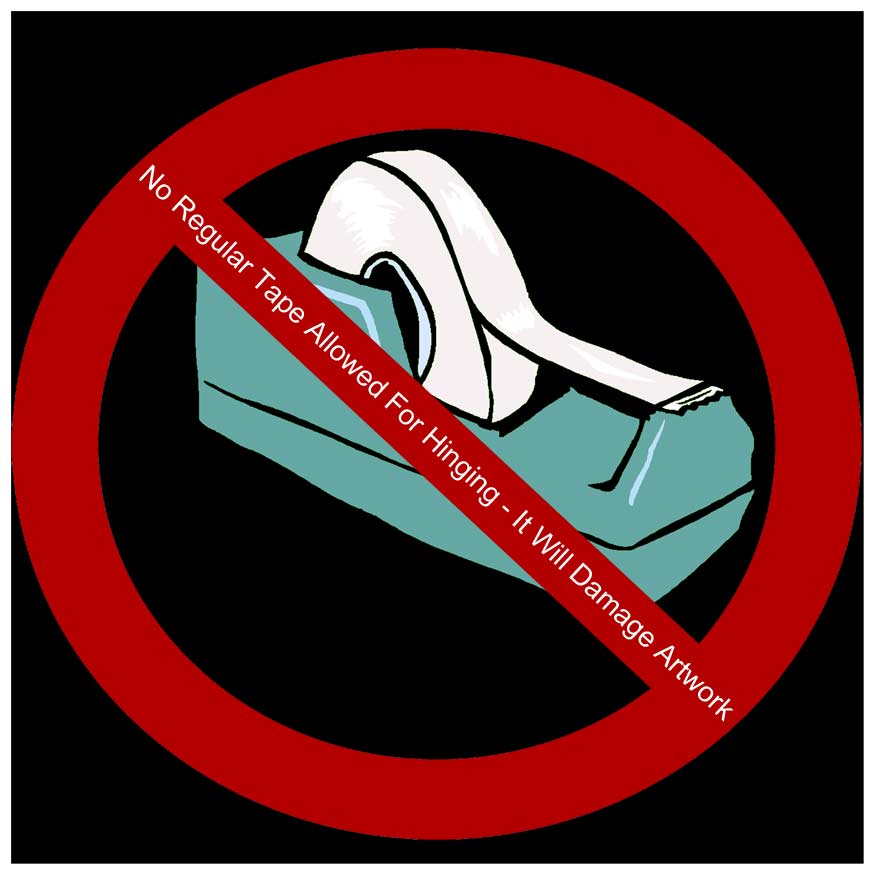 If artwork was simply laid in place, it would fall or shift out of the mat opening area. Artwork must be affixed to backing material to prevent slippage or shifting in the frame. This is an important/critical process in conservation picture framing. It is imperative that acid-free materials are used to "hinge" the artwork to the acid-free foam board or mat. There are a number of products on the market that offer what’s known as a “reversible” hinging process. This means, for example, if you had a valuable piece of art that was framed using hinges, and you wish to remove it from the frame and sell it at a later date, you would want the attachment removed without damaging the art. For this reason, we strongly encourage the use of hinging paper that is "reversible" whenever possible. A reversible hinge mount allows you to remove the artwork from the backing and remount it at a future date.
If artwork was simply laid in place, it would fall or shift out of the mat opening area. Artwork must be affixed to backing material to prevent slippage or shifting in the frame. This is an important/critical process in conservation picture framing. It is imperative that acid-free materials are used to "hinge" the artwork to the acid-free foam board or mat. There are a number of products on the market that offer what’s known as a “reversible” hinging process. This means, for example, if you had a valuable piece of art that was framed using hinges, and you wish to remove it from the frame and sell it at a later date, you would want the attachment removed without damaging the art. For this reason, we strongly encourage the use of hinging paper that is "reversible" whenever possible. A reversible hinge mount allows you to remove the artwork from the backing and remount it at a future date.
Often, non-conservation picture framers will use masking tape or even clear cellophane tape, and even shipping tape. This type of hinging is definitely detrimental to the artwork. If the artwork was fixed in place with tape, then your picture framer has done you a great injustice. Acid from the tape will run its course and in some cases, the tape will blemish the artwork, to the extent that it will bleed through the print.
Attaching Large Artwork to a Backing Board
Some objects are too large for simple hinging. For example large photographs, maps, charts, and posters fall into this category. These types of prints will wrinkle in buckle if simply hinged. However, we employ an acid-free, reversible drymount board. This drymount board allows us to flatten large prints so that they remain in place. It also has the characteristic of having a release agent built into them. This will enable us to remove the artwork at a later date, if desired.
We Use Acid-Free Adhesives
Tapes used to seal the mat board onto foam board should be acid free. Another consideration that presents itself when using adhesive’s that are not acid-free is a process known as “off-gassing.” Off-gassing is the release of chemicals from the tape/adhesive’s into the area under the glass that may damage the artwork. Although this is not an immediate process, it may eventually damage the artwork over time. To insure against this, we use only acid free adhesives. If you’re comparing us to other framers, ask them what types of materials they use for fastening objects and artwork. Make sure their answer is clearly “acid-free” materials. Under no circumstance should ordinary spray adhesive be used on prints of significant value. The adhesive is not reversible and will off-gas in the frame.
Sealing the Picture Frame Moulding To Prevent Damage
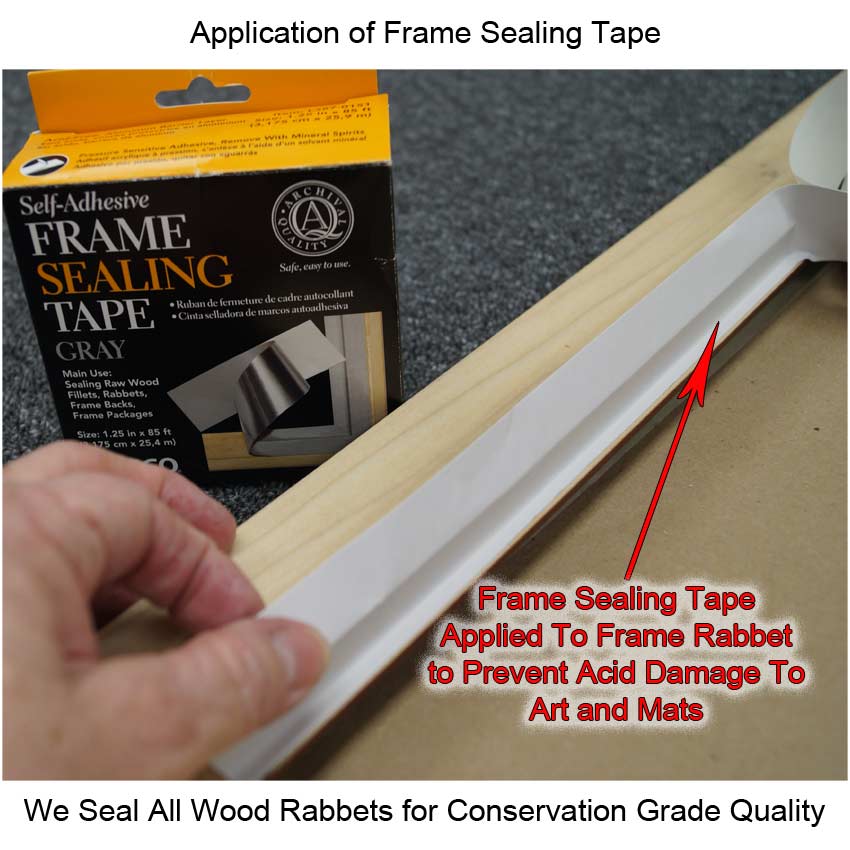 Contact with wood can have the same damaging implications as contact with poor quality mats. Because wood contains the same lignins that is in pulp mats, a potential exist for the damaging effects of acid. As wood deteriorates, it gives off acid. Some picture frame moulding is coated at the factory to prevent damage. Moulding that typically does not have a gesso finish, has a raw wood rabbet. If mats, or artwork, are allowed to touch the wood, acid will damage the art or the mats with time. Conservation framing avoids this potential damage by employing special sealing tapes to prevent direct contact with the wood. We seal the inside of any wood frame "rabbet" under the glass. This keeps the backing material, the artwork, and the mats away from the acid in the moulding. It's just another step we perform to insure your artwork is protected against the influences of acid materials.
Contact with wood can have the same damaging implications as contact with poor quality mats. Because wood contains the same lignins that is in pulp mats, a potential exist for the damaging effects of acid. As wood deteriorates, it gives off acid. Some picture frame moulding is coated at the factory to prevent damage. Moulding that typically does not have a gesso finish, has a raw wood rabbet. If mats, or artwork, are allowed to touch the wood, acid will damage the art or the mats with time. Conservation framing avoids this potential damage by employing special sealing tapes to prevent direct contact with the wood. We seal the inside of any wood frame "rabbet" under the glass. This keeps the backing material, the artwork, and the mats away from the acid in the moulding. It's just another step we perform to insure your artwork is protected against the influences of acid materials.
Avoiding Humidity Damage to Artwork
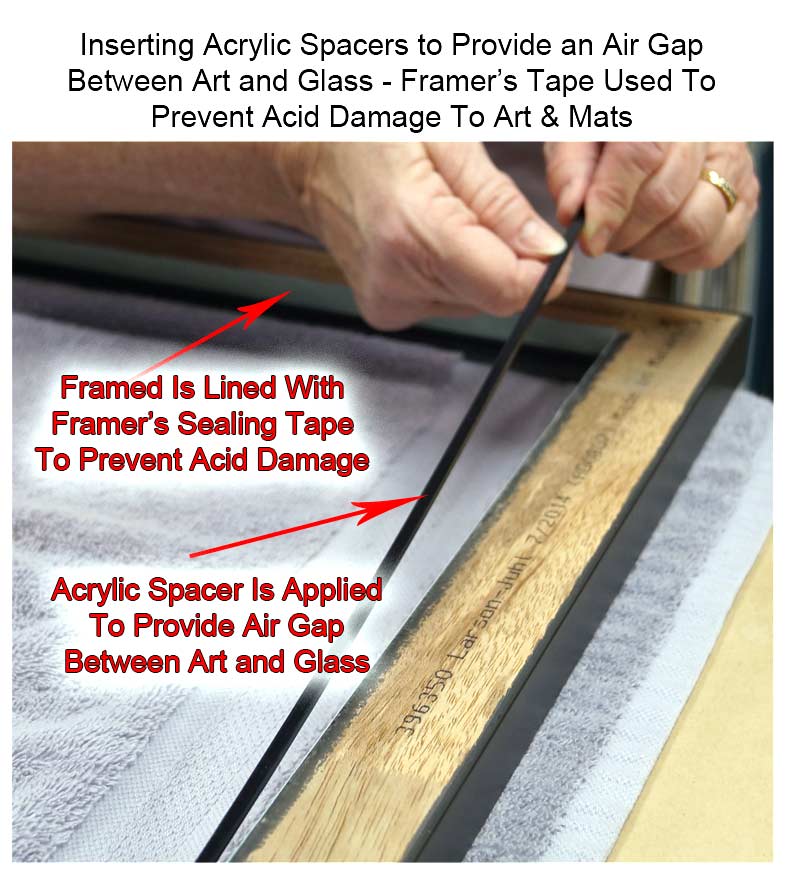 High levels of humidity present another challenge for prolonging the life of framed art. Our area experiences rather high levels of humidity for long periods throughout the year. This can be a real problem if the artwork is placed directly behind the glass in a frame. As explained in our custom framing section, matting offers a solution for providing air space. A small gap between the artwork and the glass for air is necessary. Temperature changes in the house may result in condensation or moisture on the glass. If that occurs inside the frame, then it can become a serious problem. We have had clients place art directly under air conditioning vents. This type placement is a formula for disaster! We strongly urge against this practice because of the potential for moisture buildup.
High levels of humidity present another challenge for prolonging the life of framed art. Our area experiences rather high levels of humidity for long periods throughout the year. This can be a real problem if the artwork is placed directly behind the glass in a frame. As explained in our custom framing section, matting offers a solution for providing air space. A small gap between the artwork and the glass for air is necessary. Temperature changes in the house may result in condensation or moisture on the glass. If that occurs inside the frame, then it can become a serious problem. We have had clients place art directly under air conditioning vents. This type placement is a formula for disaster! We strongly urge against this practice because of the potential for moisture buildup.
We cannot overemphasize that any artwork that touches the glass/glazing is a candidate for potential damage. In most cases, art is matted, allowing the air space mentioned above. In cases where the art does not have a mat, we utilize acrylic spacers to keep the glass away from the art. They are not seen, but provide a valuable function. Using spacers keeps moisture away from the art, the same as mats. Spacers also help prevent the growth of mold under the glass. You often see mold from moisture in the form of dark/gray spots under the glass.
Acid Free Dust and Insect Protection
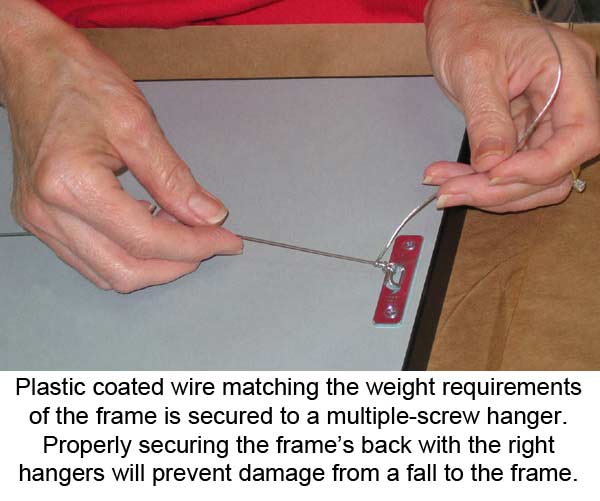 Often, the most overlooked aspect of custom framing is the back of the picture frame or a shadowbox. Most “discount” picture framers use highly acidic craft paper. Craft paper looks like an old paper grocery bag that's been sealed onto the back of the frame. The paper on the back of your framed artwork serves a useful purpose. It is there to protect against dust and insects. We believe in addition to insect and dust protection, the back dust cover should also be acid-free, and sealed in place with acid-free tape. Our acid-free backing material is light blue, not brown or black craft paper.
Often, the most overlooked aspect of custom framing is the back of the picture frame or a shadowbox. Most “discount” picture framers use highly acidic craft paper. Craft paper looks like an old paper grocery bag that's been sealed onto the back of the frame. The paper on the back of your framed artwork serves a useful purpose. It is there to protect against dust and insects. We believe in addition to insect and dust protection, the back dust cover should also be acid-free, and sealed in place with acid-free tape. Our acid-free backing material is light blue, not brown or black craft paper.
Proper Hangers & Fasteners Are Necessary
Over the years, we have repaired a lot of broken frames and replaced glass in fallen frames because the frame’s hangers failed. One of the sure bets in prolonging the life of your artwork is to hang it with the proper hanger. It may be simply overstated, but keeping your artwork from falling off the wall and sustaining damage is something we take very seriously. For this reason, we do not use screw eye hangers for affixing the wire on the back of the framed artwork. We have repaired too many frames that have fallen and been damaged because they were hung using screw eye fasteners. The single screw eye has a tendency to work itself out when the framed artwork is handled, or if the screw eye was not installed properly.
Conservation Quality Glass Is Essential
Ever had drapes by a window fade? Damaging UV (ultraviolet) light was the culprit. We believe that conservation quality glass is such an integral part of picture framing, that we do not even stock regular glass. Protection from UV light is an essential component of conservation-grade picture framing but it is often overlooked.
First, Ultra-violet light is one of the most damaging elements your artwork may encounter. UV light not only causes the colors to fade to a mere shadow of their former glory, but it causes the materials themselves to begin to break down right in the frame! Regular, clear glass will not protect your art. UV light’s damage is cumulative and irreversible. For proper protection against UV light it is necessary to use a conservation quality glass or acrylic. This glass or acrylic is specially formulated to protect framed artworks from the damaging effects of ultra-violet light. Today's conservation glass and acrylic can block over 99% of these most damaging UV light rays.
Simply removing UV light by using UV protected glass or acrylic is one of the most important steps you can take to prolong the life of your art. Another step is to avoid displaying your framed art where it is exposed to direct sunlight.
The Benefits of Conservation Picture Framing
Conservation picture framing is slightly more expensive than “discount” framing. However, art will not last long without protecting it properly. The damaging effects of UV light will show up within just a few years of exposure. We have seen this firsthand in our shop. Customers have brought us autographed mementos worth a lot of money to re-frame. In some cases, the poorly framed mementos faded to the state where the signature was barely legible. Unfortunately, this resulted in diminishing the value of the collectable item. We have also seen limited edition prints fade dramatically and lose value because of poor framing techniques and inferior methods. Skimping on conservation framing will be a lot more expensive in the long run than the initial cost savings! We believe that if something is worth framing, it is worth protecting using conservation grade materials and techniques.
We invite you to visit our shop to examine examples of damaged artwork and the results of not using conservation-grade picture framing materials and methods. Our shop is location is 10070 Ford Avenue, Richmond Hill, GA 31324. If you have any questions about protecting your art or about conservation framing, feel free to call us at 912-756-2781 or by email at cindysframing@coastalnow.net
